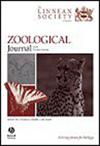Adaptation and innovation in darter fish cranial musculature (Etheostomatinae: Percidae): insights from diceCT
IF 3
2区 生物学
Q1 ZOOLOGY
引用次数: 0
Abstract
Fish skulls are often highly kinetic, with multiple linkage and lever systems powered by a diverse suite of muscles. Comparative analysis of the evolution of soft-tissue structures in the fish skull is often limited under traditional approaches, while new imaging techniques like diceCT (diffusible iodine-based contrast-enhanced computed tomography) allow for high-resolution imaging of muscles in situ. Darters (Percidae: Etheostomatinae) are a diminutive and species-rich clade of lotic freshwater fishes, which show diverse head shapes believed to be associated with different foraging strategies. We used diceCT to sample all major cranial adductors and abductors responsible for movement of the jaw, hyoid, operculum, and suspensorium from 29 species. We applied comparative phylogenetic approaches to analyse the evolutionary trends in muscle size across the clade. We found two major patterns: (i) darter cranial muscles show fundamental trade-offs relating to investment in musculature, as well as buccal expansion vs. biting attributes; early divergence in muscle size appears to be associated with shifts in habitat use and foraging; (ii) darter adductor mandibulae show high variation in architecture (fibre orientation, divisions). This study highlights how new imaging techniques can provide novel insights into the anatomy of even well-sampled/represented clades.鲯鳅颅肌的适应与创新(鳍鳅科:鲈形目):骰子CT的启示
鱼类的头骨通常具有很强的运动性,由多种肌肉组成的多个连接和杠杆系统提供动力。在传统方法下,对鱼类头骨软组织结构进化的比较分析往往受到限制,而骰CT(可扩散碘对比增强计算机断层扫描)等新成像技术则可对肌肉进行原位高分辨率成像。短吻鳄(鲈科:Etheostomatinae)是体型较小、物种丰富的荷塘淡水鱼类,其头部形状各异,据信与不同的觅食策略有关。我们使用骰子CT对29个物种中负责下颌、舌骨、厣和悬钩子运动的所有主要头颅内收肌和外展肌进行了取样。我们采用比较系统发生学方法分析了整个支系中肌肉大小的进化趋势。我们发现了两种主要模式:(i)镖鱼颅部肌肉显示出与肌肉组织投资有关的基本权衡,以及颊部扩张与咬合属性的权衡;肌肉大小的早期分化似乎与栖息地利用和觅食方式的转变有关;(ii)镖鱼下颌内收肌在结构(纤维方向、分部)方面显示出高度变异。这项研究强调了新的成像技术如何为取样/代表性良好的支系的解剖学提供新的见解。
本文章由计算机程序翻译,如有差异,请以英文原文为准。
求助全文
约1分钟内获得全文
求助全文
来源期刊
CiteScore
6.50
自引率
10.70%
发文量
116
审稿时长
6-12 weeks
期刊介绍:
The Zoological Journal of the Linnean Society publishes papers on systematic and evolutionary zoology and comparative, functional and other studies where relevant to these areas. Studies of extinct as well as living animals are included. Reviews are also published; these may be invited by the Editorial Board, but uninvited reviews may also be considered. The Zoological Journal also has a wide circulation amongst zoologists and although narrowly specialized papers are not excluded, potential authors should bear that readership in mind.

 求助内容:
求助内容: 应助结果提醒方式:
应助结果提醒方式:


